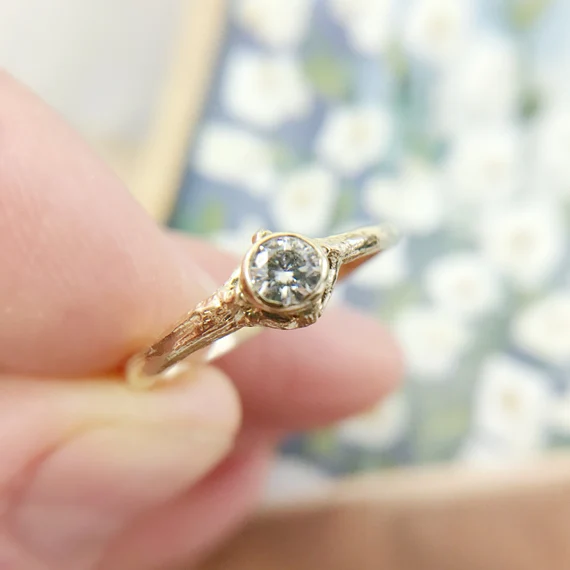
Low-profile engagement rings are fashionable and practical, and they provide an alternative to high-profile rings. They’re ideal for the modern woman who enjoys being active. But what exactly are they? That’s precisely what we’ll discuss in this blog.
Explaining What Low Profile Engagement Rings Are?
The term stems from the distance between the diamond and the ring’s band. Low-profile engagement rings have a low, flush-to-the-band setting, with the diamond’s tip resting inside rather than on top of the band. With many antique rings sporting low-profile designs, low settings have always been a favorite design choice.
Low-profile (or low-set) engagement rings have a setting that is situated low in the band of the ring. Instead of being lifted high in the air, the ring’s head, which holds the diamond or other gemstone, sits close to your finger. Bezel, prong, and halo settings with a range of stones, cuts, and shapes are popular low-set ring styles.
Because the depth of the stone influences the height of the setting, not every stone is suited to sit in a low setting. If the stone has a long girdle, the setting should be raised to accommodate it.
What is a Low Profile Bezel Set Engagement Ring?
Low-profile rings exist in a variety of shapes, but the bezel ring is the lowest-profile option. These rings have a metal band that wraps around the diamond’s girdle, keeping it close to the band.
Bezel rings ring in which the stone appears to be a part of the ring and metal is folded around the stone’s edges to keep it in place. Our Tina Bezel Three Stone Ring, which has all the hallmarks of a bezel set ring, is a fantastic illustration of this. The ring is more suited for everyday wear because of the low-profile setting.
Many individuals like the modern style of bezel rings, but if you want to change out the diamonds later, this is not the band for you. These rings are designed to contain your diamond and nothing else. Because any diamond ring is beautiful, but not all of them are functional, comfort is a top priority with these sorts of rings.
Choosing between low-profile and high-profile rings is generally a matter of personal preference and lifestyle. Here are the benefits and drawbacks of low-profile engagement rings!
Pros
- Low-profile settings have the advantage of being difficult to harm and easy to maintain clean. They also come in a variety of styles, giving you plenty of alternatives as you browse.
- Because the settings curve is lowered lower, they’re not ideal for additional stackable bands unless they’re custom matched to the shape of the curve. While you can’t stack with just any ring, many low-profile engagement rings are meant to come as a wedding set, which is both a positive and a drawback.
- The Grand Mozart Bridal Set, for example, has a stunning low-profile engagement ring and a curving stackable band encrusted with diamonds, ensuring that you have all of the glitters you require. In a manner that most uncurved bands couldn’t, the stackable band wonderfully complements the engagement ring.
Cons
- Low-profile rings have the disadvantage of the center stone not catching as much light, so you’ll miss out on some of the sides glitters that a high setting provides.
- Remember that many low-profile alternatives lack pegheads, making the setting style a fixed option. If you wish to change the shape or size of the center diamond, you’ll have to start from scratch.
- Low-profile rings are a practical tradeoff of less light exposure and customization later on in exchange for protecting your ring from an active, exciting lifestyle. They can still be quite glitzy with large center diamonds.
Why Should You Choose It?

A low-set engagement ring is appealing for a variety of reasons. Low-profile ring settings, for example, are quite comfortable to wear since they do not snag on ordinary objects. There’s less chance of the center stone catching on fabric, hair, or other items because it’s flush against your skin. This makes it a practical choice, especially if you frequently use your hands.
High-profile rings, on the other hand, can be dangerous for people who work in specific industries, such as nurses and doctors who work with gloves and physically handle other people or those who deal with various instruments. A projecting ring could catch on flesh or instruments, causing injury.
So, what’s the verdict? A low-profile ring is a preferable choice if you live an active lifestyle. Low-profile rings also provide additional security for your center stone because it is less prone to collide with hard objects. This adds another layer of protection to a valuable diamond or gemstone.
Conclusion
While there is no price difference or change in the number of options available when picking a low-profile ring setting, the key difference is in the ring’s functionality.
It all comes down to personal preference and what you want from your ring at the end of the day. For some, nothing beats the elegance of a high-profile ring, but for others, the practicality and aesthetic of a low-profile setting are worth it.
